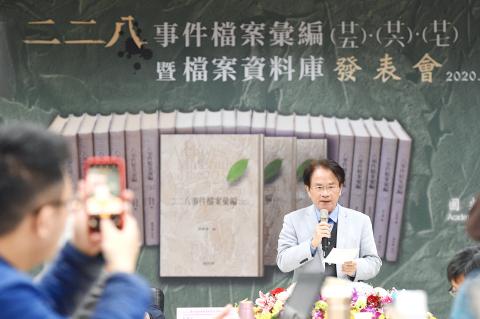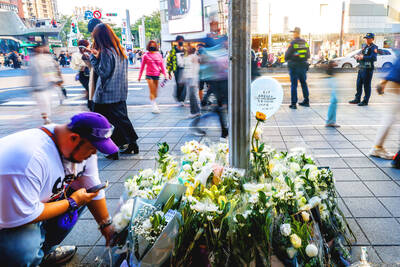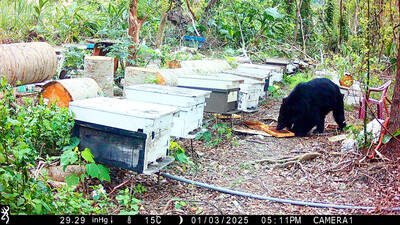A group of social activists yesterday called on President Tsai Ing-wen (蔡英文) to have all remaining symbols of White Terror era presidents removed or relocated before the end of her second term.
As someone who lived through the White Terror era, it is his greatest wish to see the symbols of Chiang Kai-shek (蔣介石) and Chiang Ching-kuo (蔣經國) — particularly the Chiang Kai-shek Memorial Hall — “dealt with,” activist Wang Wen-hung (王文宏) said.
Wang, who represents the families in Kaohsiung of victims of the 228 Incident and White Terror era, made the comment during a news conference at Academica Historica in Taipei announcing the release of three new books on the period.

Photo: George Tsorng, Taipei Times
Wang said that he had not learned until he was 18 years old that his father had been beaten to death during the 228 Incident.
The three books allowed him to verify whether information he was told about the era were accurate, he said.
The books are the result of research that was started during the administration of former president Chen Shui-bian (陳水扁), when the Democratic Progressive Party began seeking the truth about the White Terror era, Academia Historica President Chen Yi-shen (陳儀深) said.
Now that information on the era is being digitized, people seeking answers would not need to visit the archives and have documents retrieved for them and copied one at a time, like those a generation earlier did, Chen Yi-shen said.
Researchers have so far published 27 volumes filled with documents including testimonies from victims and their families, he said, adding that these first-hand accounts are invaluable to better understanding the nation’s history.
Many original documents on events of the White Terror era have gone missing, but in many cases researchers were able to find copies or supplementary documents in the archives of other government bodies, 228 Memorial Foundation chairman Hsueh Hua-yuan (薛化元) said.
Also, documents related to events in rural areas of Pingtung County and what are today parts of the special municipality of Kaohsiung were found in documents on what was then Kaohsiung county, he said.
The documents helped the researchers understand how officials of the time dealt with what was happening, he said, adding that they also showed that some officials were sympathetic toward the victims.
Some of the information collected in the 27 volumes contained details that were not mentioned in previous accounts of the era, he said.
Academia Historica has been working with the National Development Council’s National Archives Administration since 2018 to collect documents related to the era, he said, adding that together they have so far scanned 130,000 pages for digital preservation, which are all available to the public on the Internet.

SHIPS, TRAINS AND AUTOMOBILES: The ministry has announced changes to varied transportation industries taking effect soon, with a number of effects for passengers Beginning next month, the post office is canceling signature upon delivery and written inquiry services for international registered small packets in accordance with the new policy of the Universal Postal Union, the Ministry of Transportation and Communications said yesterday. The new policy does not apply to packets that are to be delivered to China, the ministry said. Senders of international registered small packets would receive a NT$10 rebate on postage if the packets are sent from Jan. 1 to March 31, it added. The ministry said that three other policies are also scheduled to take effect next month. International cruise ship operators

HORROR STORIES: One victim recounted not realizing they had been stabbed and seeing people bleeding, while another recalled breaking down in tears after fleeing A man on Friday died after he tried to fight the knife-wielding suspect who went on a stabbing spree near two of Taipei’s busiest metro stations, Taipei Mayor Chiang Wan-an (蔣萬安) said. The 57-year-old man, identified by his family name, Yu (余), encountered the suspect at Exit M7 of Taipei Main Station and immediately tried to stop him, but was fatally wounded and later died, Chiang said, calling the incident “heartbreaking.” Yu’s family would receive at least NT$5 million (US$158,584) in compensation through the Taipei Rapid Transit Corp’s (TRTC) insurance coverage, he said after convening an emergency security response meeting yesterday morning. National

PLANNED: The suspect visited the crime scene before the killings, seeking information on how to access the roof, and had extensively researched a 2014 stabbing incident The suspect in a stabbing attack that killed three people and injured 11 in Taipei on Friday had planned the assault and set fires at other locations earlier in the day, law enforcement officials said yesterday. National Police Agency (NPA) Director-General Chang Jung-hsin (張榮興) said the suspect, a 27-year-old man named Chang Wen (張文), began the attacks at 3:40pm, first setting off smoke bombs on a road, damaging cars and motorbikes. Earlier, Chang Wen set fire to a rental room where he was staying on Gongyuan Road in Zhongzheng District (中正), Chang Jung-hsin said. The suspect later threw smoke grenades near two exits

The Forestry and Nature Conservation Agency yesterday launched a gift box to market honey “certified by a Formosan black bear” in appreciation of a beekeeper’s amicable interaction with a honey-thieving bear. Beekeeper Chih Ming-chen (池明鎮) in January inspected his bee farm in Hualien County’s Jhuosi Township (卓溪) and found that more than 20 beehives had been destroyed and many hives were eaten, with bear droppings and paw prints near the destroyed hives, the agency said. Chih returned to the farm to move the remaining beehives away that evening when he encountered a Formosan black bear only 20m away, the agency said. The bear